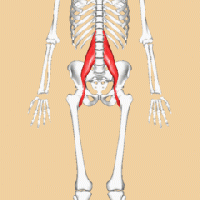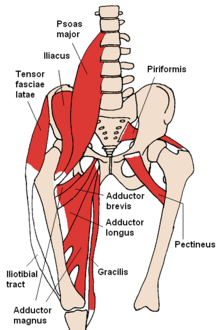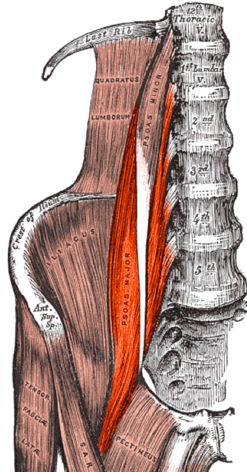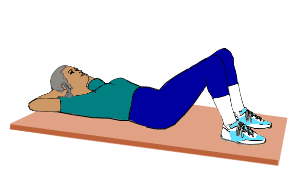Psoas Major
Original Editor - Oyemi Sillo
Top Contributors - Vidya Acharya, Samrah khan, Lucinda hampton, Oyemi Sillo, Kim Jackson, George Prudden, Samson Chengetanai, Joao Costa, Maram Salem, Rachael Lowe and Kardelen Aktas;
Introduction[edit | edit source]
The psoas muscle is a paraspinal muscle located deep in the body. It lays close to the spine on either side and extends distally to the brim of the lesser pelvis. It combines with the iliacus muscle to form the iliopsoas muscle closer to the insertion point. Due to its proximity to the lumbar vertebrae, it plays an important role in back health. It also acts to both laterally flex the lumbar spine and assists with flexion and external rotation of the hip.[1] [2]It is essential for correct standing or sitting lumbar posture, stability of the hip joint, and during walking and running[3].
Anatomy[edit | edit source]
Origin
The psoas muscle contains superficial and deep parts owing to the presence of branches of the lumbar plexus running through it. Superficially, it originates along the lateral surface of the distal thoracic vertebrae and adjacent intervertebral discs. The deeper portion originates at the first four lumbar vertebrae.[2]
Insertion
The fibres of the muscle converge from its wide origin as they descend on the posterior abdominal wall. They cross the pelvic inlet to form a long tendon, which is joined within the pelvic region by fibres from the iliacus muscle, finally inserting into the lesser trochanter of the femur.
Bursa
Below the insertional tendinous unit is the iliopsoas bursa, which separates the tendon from the bone surface and the proximal portion of the femur.
Fibre Types
In humans, the psoas major muscle fibres are mainly represented by anaerobic, fast oxidative (about 60%), while the remaining percentage consists of aerobic, slow oxidative (about 40%). This demonstrates the psoas muscle's important role in dynamic function and simultaneous role for postural support. At the site of its origin, there are more anaerobic fibres present for static (postural) function. Distally and closer to the insertion point, there are more aerobic fibres to assist with dynamic function[3].
Nerve Supply
Branches from the anterior rami of lumbar spinal nerves L1-L4 before they join to form the lumbar plexus. The lumbar plexus is embedded within the psoas major muscle and its branches emerge from it.[1]The psoas muscle also receives small branches from the femoral nerve.
Blood Supply
The muscle receives blood from the four lumbar arteries from the aorta, from small branches of the renal arteries, from small muscular branches of the common iliac artery, and from the deep circumflex iliac artery[4].
Function[edit | edit source]
The psoas major muscle functions as a static and dynamic muscle. It sits at a juncture between the upper and lower body. Due to its respective origin and insertion points, it also functions as a "front to back" muscle given its placement with various superior, medial, and inferior portions of fascial tissue as it descends through the pelvic cavity.
The psoas major combines itself with the iliacus muscle. With this contribution, it acts as a hip flexor in both supine and standing. When in a static position (sitting), it acts as a stabilizer for the lumbar spine. The psoas major muscle also stabilizes the femoral head within the acetabulum of the hip in the first 15 degrees of movement. [3]Since the psoas muscle has two segments, one each side of the body, it assist with lateral motions (unilateral side contraction) or with bilateral motions (both right and left psoas major contractions). An example of a bilateral motion is trunk elevation when transitioning from a supine to sitting/standing position.[1]
Since it inserts distally at the lesser trochanter of the femur, it acts as a hip flexor, hip adductor, and hip external rotator. When standing upright, unilateral contraction will yield flexion of the lumbar spine, sidebending the lumbar spine to the ipsilteral side with simultaneous contralateral rotation (e.g., left psoas major contraction will yield sidebending towards the left with rotation to the right).
The psoas muscle is also one of the core muscles.
Physiotherapy Relevance[edit | edit source]
When your psoas muscle gets too tight or shortened, it may arched back ie lumbar hyperlordosis, especially if the abdominal muscles are challenged eg in curl up.
If the psoas is weak, it will likely be harder to flex the hip joint, negatively affecting the ability to climb stairs, walk uphill, get up from supine or preparing to stand up from a sitting position[5].
See also
Resources[edit | edit source]
A good 2 and 1/2 minute video on the anatomy of the psoas major. [6]
References[edit | edit source]
- ↑ 1.0 1.1 1.2 Bogduk NP, Pearcy M, Hadfield G. Anatomy and biomechanics of psoas major. Clinical Biomechanics. 1992 May 1;7(2):109-19.
- ↑ 2.0 2.1 Siccardi MA, Tariq MA, Valle C. Anatomy, bony pelvis and lower limb, psoas major.
- ↑ 3.0 3.1 3.2 Bordoni B, Varacallo M. Anatomy, bony pelvis and lower limb, Iliopsoas Muscle.
- ↑ http://www.wheelessonline.com/ortho/psoas
- ↑ Very well health Psoas Muscle and Your Low Back Health Available:https://www.verywellhealth.com/psoas-muscle-and-your-low-back-health-297061 (accessed 16.1.2022)
- ↑ Psoas major muscle video - © Kenhub https://www.kenhub.com/en/library/anatomy/psoas-major-muscle











